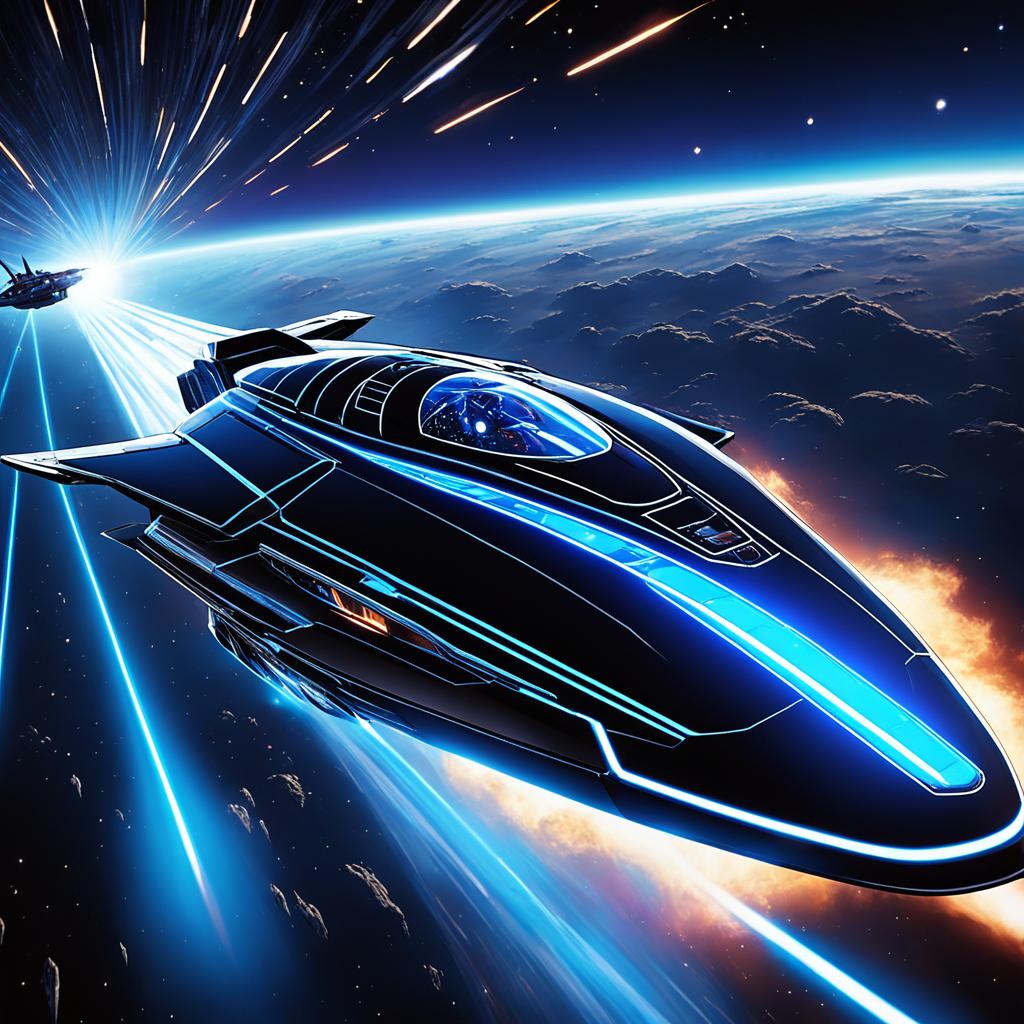Have you ever wondered how long it would take to travel 4 light-years, the distance to our nearest neighboring star? The answer may surprise you. According to current technology, it would take about 6,300 years to travel 4.2 light-years to Proxima Centauri, our nearest neighboring star. That’s a journey spanning multiple generations, with countless challenges and considerations to overcome.
To embark on such a journey, a multigenerational crew would be necessary. This crew would have to maintain a genetically healthy population, carefully considering factors such as crew size, age, life expectancy, infertility rates, and the maximum capacity of the ship. The Heritage algorithm predicts that a minimum crew of 98 settlers is needed for a successful 6,300-year journey.
Join us as we delve into the fascinating world of interstellar travel, exploring the challenges and possibilities of traversing vast distances in space, as well as the potential for future advancements in technology. Discover the intricacies of light-years, the difficulties of maintaining genetic diversity during a multigenerational journey, and the need for innovative propulsion systems. Let’s unravel the mysteries of our nearest exoplanet and envision a future where interstellar colonization becomes a reality.
Understanding Light-Year and Interstellar Travel

Have you ever wondered just how vast the distances are in space? To comprehend the immense scale of interstellar travel, it’s essential to understand the concept of a light-year. A light-year is the distance that light travels in one year, which is approximately 5.88 trillion miles. Traveling at the incredible speed of light, it would take about 4.25 years to reach Proxima Centauri, our nearest neighboring star, which is 4.2 light-years away.
So, how fast does light actually travel? Light zips through interstellar space at a mind-boggling speed of 186,000 miles per second. But even at this remarkable pace, the vast distances of space make interstellar travel a daunting challenge. The universe is filled with an enormous number of celestial bodies, each one adding to the complexity of venturing to distant exoplanets.
Imagine embarking on a journey that spans trillions of miles, spanning multiple light-years. The sheer size of space and the distances among celestial bodies make interstellar travel an awe-inspiring, almost unfathomable endeavor. Yet, the pursuit of understanding and exploring the universe continues to fuel our curiosity and drive advancements in space exploration technology.
The Challenges of Interstellar Travel

Interstellar travel presents a multitude of challenges that must be addressed to ensure a successful journey. One significant challenge involves maintaining genetic diversity within the crew to guarantee a genetically healthy population over the course of a multigenerational expedition.
Genetic diversity is crucial for the long-term sustainability of the crew and their ability to adapt to unforeseen circumstances. A diverse gene pool enhances resistance to diseases, increases overall resilience, and promotes the overall success of the mission. Without sufficient genetic diversity, the crew could be more susceptible to health issues and genetic disorders.
To tackle this challenge, strict breeding rules and parameters must be established and followed throughout the journey. These rules govern the age at which procreation is permitted, limitations on the closeness of relationships between crew members, and the number of children allowed per individual.
For example, establishing an appropriate age for procreation ensures that individuals have reached physical and emotional maturity, reducing the risk of complications during pregnancy and childbirth. Limitations on the closeness of relationships help maintain genetic variety by preventing excessive inbreeding.
The Heritage algorithm, which provides insights into maintaining a genetically healthy population, suggests that a crew size of 98 settlers is necessary for a successful interstellar journey. This number allows for a sufficient gene pool that can withstand potential challenges and genetic bottlenecks.
By carefully considering and implementing breeding rules, as well as fostering genetic diversity, interstellar missions have a higher likelihood of success in maintaining a healthy crew population and overcoming the obstacles of long-term space travel.
The Need for Advances in Propulsion Technology

The speed of spacecraft has significantly increased over time thanks to state-of-the-art space technology. For instance, the Parker Solar Probe is expected to travel at more than 700,000 kilometers per hour. However, even with these advancements, the speed of current human spacecraft is insufficient for interstellar travel. To reach Proxima Centauri, it would still take approximately 6,300 years.
Therefore, further progress in propulsion technology is essential to reduce travel time and make interstellar travel more feasible. Several concepts show promise in this regard.
- The Project Orion proposes using nuclear blasts for propulsion, harnessing the energy from nuclear reactions to propel spacecraft forward. This method offers the potential for significantly faster travel.
- Another concept, the VASMIR ion drive, utilizes electromagnetic forces to propel spacecraft. It offers greater efficiency compared to traditional chemical propulsion, which could lead to faster travel speeds.
Advancements in propulsion technology are vital to overcoming the challenges associated with interstellar travel and reducing travel time to distant stars. These innovations hold the key to unlocking the potential of exploring the vast reaches of space.
| Advancement | Description |
|---|---|
| Project Orion | Utilizes nuclear blasts for propulsion |
| VASMIR ion drive | Utilizes electromagnetic forces for propulsion |
Proxima Centauri b – Earth’s Nearest Exoplanet
Proxima Centauri b is an exoplanet that orbits Proxima Centauri, Earth’s nearest neighboring star. This potentially habitable exoplanet has captured the attention of astronomers and space enthusiasts alike.
Proxima Centauri b is classified as a rocky, terrestrial planet, similar to our own planet Earth. Its proximity to its star places it within the habitable zone, also known as the Goldilocks zone, where conditions may be suitable for the presence of liquid water.
If Proxima Centauri b has an atmosphere, which is yet to be confirmed, the surface temperature is estimated to range from 86 to 104 degrees Fahrenheit. Without an atmosphere, the temperature could drop significantly to -22 to -40 degrees Fahrenheit.
However, the potential habitability of Proxima Centauri b is not without challenges. Being in close proximity to its star, the exoplanet is exposed to intense ultraviolet and X-ray flares that could adversely affect its chances of supporting life.
Further exploration and research are needed to understand the composition of Proxima Centauri b’s atmosphere and determine whether it possesses the necessary conditions for the existence of liquid water, a crucial ingredient for life as we know it.
| Factor | Status |
|---|---|
| Terrestrial Surface | Confirmed |
| Proximity to Proxima Centauri | Confirmed |
| Potential Liquid Water | Unknown |
| Atmosphere | Unknown |
| Surface Temperature | Estimates |
| Intense Flares | Confirmed |
Future Possibilities and Exploration
The future of interstellar travel holds exciting prospects for advancements in propulsion technology and a deeper understanding of fertility rates in deep space. As scientists and engineers continue to push the boundaries of space exploration, the potential for faster spacecraft speeds and decreased travel time becomes a tantalizing possibility.
One area of exploration is the development of future propulsion technology. With ongoing research and innovation, new propulsion methods may emerge that allow for faster and more efficient space travel. Concepts such as ion drives, nuclear propulsion, and other advanced propulsion systems are being explored to propel spacecraft at unprecedented speeds.
Simulations and studies, like the Heritage algorithm, provide valuable insights into the parameters required for successful space missions. By considering factors such as crew size, genetic diversity, and fertility rates, scientists can better understand the challenges and requirements of long-duration journeys into deep space.
Science fiction novels, like Neal Stephenson’s “Seveneves,” also present a thought-provoking exploration of the possibilities and challenges of interstellar travel. These stories delve into the complexities of sustaining a viable population, adapting to the harsh conditions of space, and overcoming unforeseen obstacles on long space journeys.
As we continue to gaze toward the stars, the quest for interstellar travel remains a beacon of human curiosity and ambition. With ongoing advances in technology, a better understanding of deep space fertility rates, and the exploration of new frontiers, the day when humanity embarks on long-distance space missions may not be as far away as we once thought.
Conclusion
As we contemplate the idea of interstellar colonization, we are faced with the reality that the current technology makes traveling 4 light-years an immense challenge. However, it is important to recognize that advancements in propulsion technology and our understanding of space colonization are continuously evolving.
Humanity’s dream of interstellar exploration and the colonization of distant exoplanets, like Proxima Centauri b, remains a goal for the future. With continued research, innovation, and investments in space exploration, we may one day witness humans embarking on long journeys to explore the vastness of the universe.
The potential for interstellar colonization relies heavily on advancements in technology that can offer faster, more efficient means of propulsion. As we push the boundaries of engineering and scientific knowledge, these advancements will continue to shape the future of space exploration and colonization.
While interstellar colonization may currently seem like science fiction, it is crucial to remain optimistic and supportive of scientific endeavors. The ongoing pursuit of knowledge and the commitment to advancing technology could eventually unlock the possibility of reaching and settling new worlds beyond our own.
FAQ
Q: How long would it take to travel 4 light years?
A: According to current technology, it would take about 6,300 years to travel 4.2 light-years to Proxima Centauri, our nearest neighboring star.
Q: What is a light-year and how does it relate to interstellar travel?
A: A light-year is the distance light travels in one year, which is approximately 5.88 trillion miles. Traveling at the speed of light, it would take about 4.25 years to reach Proxima Centauri, which is 4.2 light-years away.
Q: What are the challenges of interstellar travel?
A: One of the key challenges is maintaining genetic diversity within the crew to ensure a genetically healthy population over the course of a multigenerational journey. Parameters such as crew size, age, life expectancy, infertility rates, and maximum capacity of the ship need to be considered.
Q: Why is advances in propulsion technology necessary for interstellar travel?
A: Even with state-of-the-art space technology, it would still take about 6,300 years to reach Proxima Centauri. Advances in propulsion technology are necessary to decrease travel time and make interstellar travel more feasible.
Q: What is Proxima Centauri b?
A: Proxima Centauri b is an exoplanet that orbits Proxima Centauri, Earth’s nearest neighboring star. It is considered a potentially habitable exoplanet due to its rocky, terrestrial surface and its proximity to its star.
Q: What is the future of interstellar travel?
A: The future of interstellar travel holds possibilities for advancements in propulsion technology, as well as a better understanding of fertility rates in deep space. Scientists and engineers continue to explore ways to improve spacecraft speeds and decrease travel time.
Q: Will humans be able to embark on long journeys to distant exoplanets?
A: While the current technology may make traveling 4 light-years a formidable challenge, advancements in propulsion technology and understanding of space colonization are constantly evolving. With continued research and innovation, humans may one day be able to explore distant exoplanets like Proxima Centauri b.
